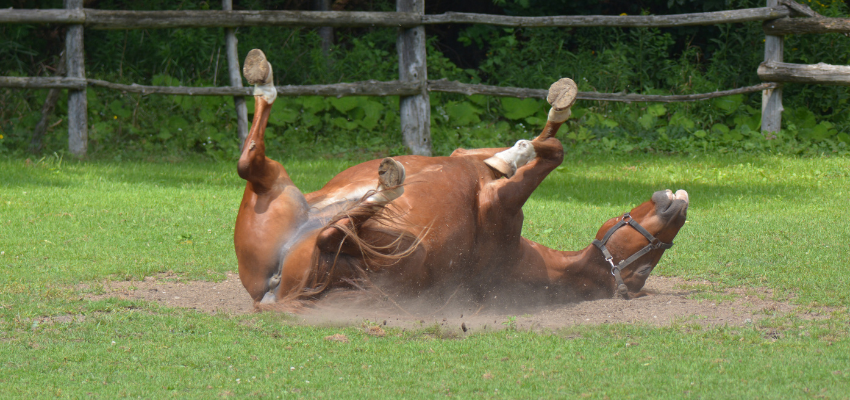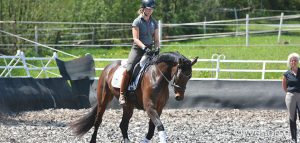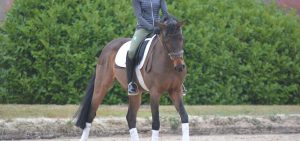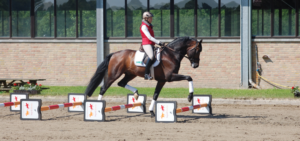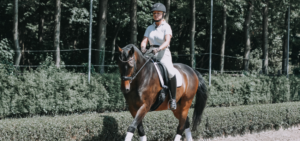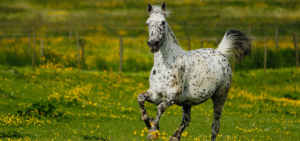Colic is a common gastrointestinal issue in horses that can not only lead to abdominal pain but potentially be life-threatening. But what exactly is colic in horses and how can you prevent it? In this article, you’ll learn everything about this condition, from its causes and symptoms to its diagnosis, treatment, and prevention.
What exactly is colic in horses?
Colic isn’t a distinct disease but rather a general term for gastrointestinal diseases that lead to discomfort or cramp-like pains in the abdominal cavity. Typically, gastrointestinal issues cause colic in horses. However, issues with the bladder, kidneys, or reproductive organs can also lead to colic.
Why is a horse’s gastrointestinal tract so sensitive?
As a grazing animal, horses are used to constantly eating slowly. If their environment doesn’t allow it, they often eat too quickly or too much. As a result, the horse’s relatively small stomach fills up quickly. Due to their anatomy, horses cannot vomit. They can only move ingested food towards the intestine.
On the other hand, a horse’s 30-meter-long intestine has a lot of mobility, which can easily lead to twists or shifts.
Furthermore, a horse’s intestine is generally very sensitive. Diseases, stress, little exercise, weather changes, or food can immediately affect the horse’s gastrointestinal tract.
How do I recognize colic in horses?
Quick action is essential when dealing with colic. Thus, it’s vital to recognize the colic symptoms and signs early on. Veterinarians often differentiate between the symptoms of mild and severe colics.
Symptoms of mild colic in horses include:
Signs of a mild colic can include:
- Restlessness
- Flehmen (lip curling)
- Scratching or stomping
- Kicking the belly with the hind legs
- Frequently looking at the belly
- Stretching
- Increased urination
- Decreased food intake
- Not passing stool
- Frequently lying down and rolling
Symptoms of severe colic in horses include:
These signs indicate a severe colic:
- Profuse sweating
- Circulatory disorders
- Rapid and shallow breathing
- Fast pulse
- Apathy
- Bloated belly
- Cramped abdominal muscles
- Frequent and intense rolling
- Refusing food and water
- Few to no intestinal sounds
Horses vary in their pain responses. Some horses are sensitive and express their pain well. Others are less sensitive. Therefore, the intensity of a symptom doesn’t necessarily reflect the severity of the colic.
First Aid Measures
If you notice colic symptoms in your horse, contact your veterinarian immediately. While waiting for the vet, you can employ the following first-aid measures:
- Stay calm, even if it’s challenging.
- Don’t let your horse eat or drink.
- Walk your horse to stimulate circulation and intestinal activity.
- Try not to let your horse lie down or roll. If they do, encourage them to stand up again.
- Monitor your horse’s urine and stool.
- If your horse sweats heavily, use a sweat sheet to prevent chilling.
- Ensure a horse trailer is available in case you need to transport the horse to a clinic.
- Measure the vital signs.
How do I measure my horse’s vital signs?
The vital signs comprise measurements for pulse, breathing, and temperature. Ideally, you should know your horse’s normal values. If you’re unsure, you can refer to these average values for healthy adult horses:
- 28-40 beats per minute
- 8-16 breaths per minute
- 37-38.3°C body temperature
To measure your horse’s pulse, check under its jaw. Other options include the underside of the tail dock or the pastern. Use your index and middle finger, as the thumb has its pulse, which could distort your reading. Measure the pulse for 15 seconds and multiply by four to get the rate for one minute.
To measure your horse’s breathing frequency, observe its flanks. Count one inhalation and exhalation as a single breath. Measure for 30 seconds and double the number to get the rate for one minute.
You can measure your horse’s body temperature using a thermometer, inserting it into the horse’s rectum while holding it throughout the measurement.
What causes colic in horses?
There are different types of colic, which can be triggered by a variety of causes.
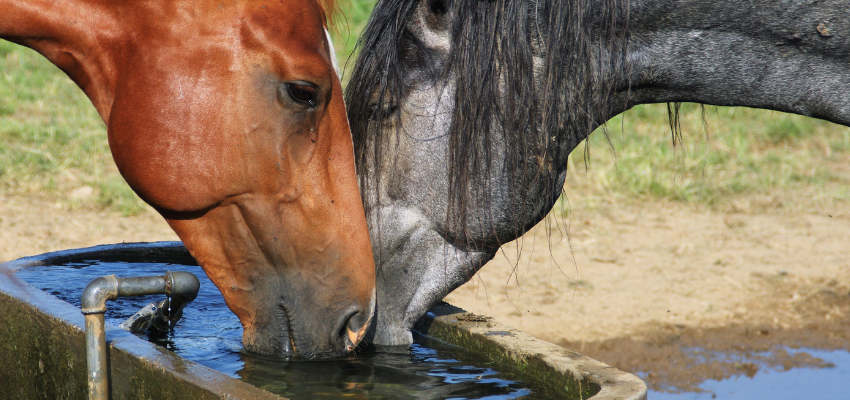
Impaction Colic
In impaction colic, the intestinal contents of your horse are too solid and can no longer be transported and excreted through the digestive tract. The most common causes of impaction colic, related to horse care and feeding, include:
- Insufficient hay
- Too much straw
- Not enough water
- Overfeeding or rapid food consumption
- Lack of movement
- Poorly chewed food due to dental problems
- Severe worm infestation
You can differentiate between two types of impaction colics. A large intestine colic can sometimes last several days. Its course is rather mild, and the chances of recovery are quite good. In the case of a small intestine colic, due to constrictions of the small intestine, surgery is often unavoidable. However, the chances of recovery are also quite good.
Spasmodic Colic
In spasmodic colic, also known as spastic colic, your horse’s intestinal activity is sporadically very high. This results in recurring, intense painful cramps. The causes of spasmodic colic are often related to feeding:
- Poorly chewed food due to dental problems
- Change in feed
- Stress
- Change in weather
- Severe worm infestation
If left untreated, spasmodic colic can lead to intestinal torsion.
Gas Colic
A horse suffering from gas colic tends to have excessive gas in its abdomen. A noticeably larger belly size is also a symptom. This type of colic is often caused by:
- Fermenting and bloating food such as mowed grass, spoiled food, clover, beets, bread, or corn.
If gas colic is left untreated, like with spasmodic colic, it can lead to intestinal torsion.
Sand Colic
In sand colic, sand accumulates over time in your horse’s large intestine and doesn’t move along. Large amounts of sand in the intestine can cause the large intestine to twist, necessitating surgery. Sand colic can be caused by:
- Heavily grazed pastures
- Sandy paddocks
- Consuming food from sandy grounds
Intestinal Torsion
The most common cause of intestinal torsion is fermentation in the intestine, leading to gas build-up. Triggers can be poor-quality feed or rapid feed transition. Due to the gas, part of the intestine rises while another part descends because of overload. If your horse is active and rolls, the intestine can twist.
Intestinal Blockage
Such intestinal torsion poses a risk of complete intestinal obstruction that nothing can pass through anymore. At the same time, the blood supply is cut off at the affected area and the intestine is at risk of dying. Impaction, gas, spasmodic, and sand colics can also lead to an intestinal blockage. In some cases, poorly chewed, large pieces of food can narrow or entirely block an intestine. This type of colic is particularly dangerous and usually requires surgical treatment.
How is colic in horses diagnosed?
When your vet arrives, they will carry out an accurate diagnosis to treat your horse. A colic diagnosis in horses includes:
- General Examination: The vet will first conduct a general examination of your horse, observing its behavior and symptoms. They will also re-measure the vital signs and ask you various questions about your horse’s care, feeding, previous illnesses, and deworming.
- Stethoscope: With a stethoscope, a vet listens to your horse’s abdomen and intestines for sounds.
- Rectal Examination: In a rectal examination, the vet inserts their arm into the horse, enabling them to feel a significant part of the abdominal cavity.
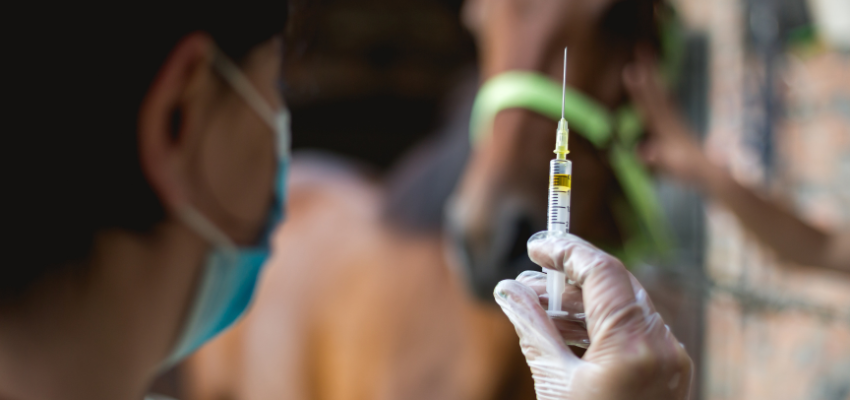
How is colic in horses treated?
Depending on the type and extent of the colic, the vet will treat your horse. Treatment may include:
- Injection: For mild colic, a spasm-relieving and pain-relieving injection is often sufficient to relax the intestine and restore intestinal activity.
- Nasogastric Tube: Using a nasogastric tube can help release gas or obstructions.
- Surgery: If there’s no improvement with medications, surgery may be necessary.
What is the cost of colic surgery for a horse?
The cost of colic surgery for a horse and postoperative care can range between $5,000 – $15,000. To protect yourself from high surgery costs, insurance might be beneficial.
Feeding after colic
Feeding your horse after a colic episode should be done in consultation with your vet. You should feed your horse high-quality hay and encourage it to drink a lot. Mash or oil feeding is often recommended.
Riding after colic
Once your horse has recovered from colic, you can start riding again after two to three days. Gradually increase your training.
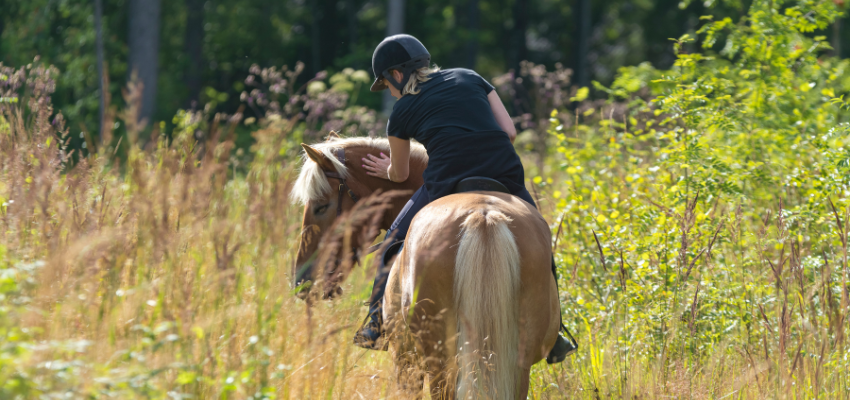
How can I prevent colic in horses?
These measures can help reduce the likelihood of colic in horses:
- Feeding: Ensure your horse always has access to sufficient high-quality roughage in the form of hay or silage and fresh, clean water. Avoid long feeding breaks. Also, avoid sudden feed changes. Gradually introduce your horse to pasture in the spring to accustom its digestive tract to fresh grass. If your horse requires concentrated feed, divide it into multiple meals.
- Movement: Regular movement is essential for healthy digestion and promotes your horse’s intestinal activity. Are you looking for training inspiration? On our website, you will find a variety of ideas and exercises for ground work, in-hand work, or riding.
- Dental Checks: Regularly have your horse’s teeth checked to ensure it doesn’t have dental problems and can chew its food properly.
- Deworming: Deworm your horse regularly to avoid parasite infestations, such as worms.
- Stress Reduction: Horses are sensitive and can easily become stressed, which affects their digestion. Thus, try to reduce stress for your horse. Here, Linda Tellington Jones shows you how to help your horse reduce stress and promote relaxation using the world-famous TTouches.
Our Conclusion
Colic is a collective term for various diseases of a horse’s gastrointestinal tract. It can be triggered by various factors. Colic in horses can quickly become life-threatening. It’s essential to recognize the symptoms early and for the vet to start appropriate treatment promptly.


